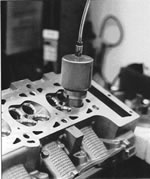
Owns and operates Westech Automotive, Inc., a machine shop and vehicle repair service business located in Silver Lake, WI.
Will machine shops be able to pass added technology cost onto their customers?
After a recent tour of the DaimlerChrysler Kenosha, WI engine plant, I came away with a lot more questions than answers about the future of engine rebuilding, especially for small and medium shops. The procedures I saw may even cause problems for the large production rebuilders.
I watched two different production lines in operation. One line produced the 4.0L six cylinder used in the Jeep. The other line made the 2.7L V6 used in the new Chrysler 300M, the Concorde and the Dodge Intrepid.
The 4.0L won't present any special problems for an engine rebuilder; it is an old war horse with a cast iron block and head, and aftermarket parts are readily available. Furthermore, machine work to rebuild a 4.0L will not require any new equipment or skills.
On the other hand, watching the 2.7L being made raised a lot of questions about the challenges that will confront engine rebuilders. Although my comments are based on watching the 2.7L, one of DaimlerChrysler's most sophisticated engines to come off the line, all of the major carmakers are using similar techniques to produce their newest engines.
Tighter specifications
The deck, or joint face as DaimlerChrysler calls it, passes through a multi-step surfacing procedure using multi-blade polycrystalline diamond cutters (PCD). When the surfacing is completed, the deck on the 2.7L head is finished to a smoothness of 0.5 to 1.25 micrometers Ra. The finish is so smooth, you could mount a 2.7L head on the wall of your bathroom and use it as a mirror when you shave. Similar multi-step machining processes are used on all the critical surfaces of the 2.7L.
The largest production engine rebuilders might be able to afford the precision cutters and special setup jigs that the OEMs use, but the cost would be out of reach for most machine shops.
The deck, or joint face as DaimlerChrysler calls it, passes through a multi-step surfacing procedure using multi-blade polycrystalline diamond cutters (PCD). When the surfacing is completed, the deck on the 2.7L head is finished to a smoothness of 0.5 to 1.25 micrometers Ra. The finish is so smooth, you could mount a 2.7L head on the wall of your bathroom and use it as a mirror when you shave. Similar multi-step machining processes are used on all the critical surfaces of the 2.7L.
I know some people say extremely precise and smooth finished can be achieved using conventional cutting and milling machines. All you have to do is reduce the feed rate to as slow as an inch per minute and use the sharpest cutting edge possible. To me, that is like saying a surgeon can do just as good a job with an axe as he can with a scalpel; he just has to take a little more time. There is no substitute for precision equipment and trained technicians when you have to do precision work.
The quality control checks were also impressive. DaimlerChrysler uses a special air gauge to measure the seal of the valve seat after it is installed in the head. The fixture is inserted into the valve seat and a metered amount of air is forced through the fixture. The amount of air leakage, which measures the quality of the seal, is read on a digital readout. Air gauges are fairly common in aviation applications, but this level of quality control precision is now becoming common in the automotive industry.
At another station, a computer controlled set of electronic probes measured all critical valve dimensions including concentricity, roundness, deck-to-valve height, valve guide clearance and the relationship between the valve guide position and the seat face. The computer program prompts the quality control technician to insert the correct probe for each measurement.
